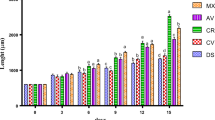Abstract
Pond-nursed pike-perch (Sander lucioperca) fry were trained to artificial diet and reared under controlled conditions maintained in aquaria using three stocking densities (1.25, 1.66 and 2.08 g/l). Two replicates per treatment were applied. The survival during the 4-week period of the experiment ranged from 44.2 to 49.6%. The majority of the losses were caused by cannibalism; only 8–14% could be attributed to natural mortality. Both cannibalism and natural mortality occurred in the first 2–3 weeks of rearing. The differences in the rate of cannibalism were independent of the stocking density. Natural mortality decreased with increasing density, consequently the highest survival was observed under the highest stocking density. Stocking density did not significantly influence growth, feed consumption and feed conversion ratio of the pike-perch fingerlings (p < 0.05).
Similar content being viewed by others
References
Chesire W.F. and Steele K.L. 1972. Hatchery rearing of walleye using artificial food. Progressive Fish-Culturist 34: 96-99.
Hilge V. 1990. Observations on the rearing of perch-pike (Stizostedion lucioperca L.) in the laboratory. Archiv fur Fischereiwissenschaft 40 (1-2): 167-173.
Klein Breteler J.G.P. 1989. Intensive culture of pike-perch fry with live food. pp. 203-207. In: N. DePauw et al. (eds). Aquaculture-A Biotechnology in Progress. Vol. 1. European Aquaculture Society, Bredene, 1220 pp.
Krise W.F. and Meade J.W. 1986. Review of the intensive culture of walleye fry. Progressive Fish-Culturist 48 (2): 81-89.
Kuipers K.L. and Summerfelt R.C. 1994. Converting pond-reared walleye fingerlings to formulated feeds: effects of diet, temperature and stocking density. Journal of Applied Aquaculture 4 (2): 31-57.
Mani-Ponset L., Diaz J.P., Schlumberger O. and Connes R. 1994. Development of yolk complex, liver and anterior intestine in pike-perch larvae, Stizostedion lucioperca (Percidae), according to the first diet during rearing. Aquatic Living Resources 7: 191-202.
Molnár T., Hancz Cs., Molnár M. and Stettner G. 2000. Investigations on technological parameters in intensive rearing of pike-perch (Stizostedion lucioperca). Acta Agraria Kaposváriensis 4 (2): 85-94 (in Hungarian)
Nagel T.O. 1976. Intensive culture of fingerling walleye on formulated feeds. Progressive Fish-Culturist 38: 90-91.
Proteau J.-P., Schlumberger O. and Albiges Ch. 1993. Sandre: Des efforts encore sur reproduction et élevage larvaire. Aqua Revue 47: 23-26.
Ruuhijärvi J., Virtanen E., Salminen M. and Muyunda M. 1991. The growth and survival of pike-perch, Stizostedion lucioperca L., larvae fed on formulated feeds. In: P. Lavens et al. (eds). Larvi '91, EAS Special Publication No. 15, Gent, pp. 154-156.
Schlumberger O. and Proteau J.P. 1991. Production de juveniles de sandre (Stizostedion lucioperca). Aqua Revue 36: 25-28.
Szkūdlarek M. and Zakçás Z. 2002. The effect of stock density on the effectiveness of rearing pikeperch Sander lucioperca (L.) summer fry. Arch. Pol. Fisheries 10 (1): 115-119.
Zakçás Z. 1997a. Converting pond-reared pike-perch fingerlings, Stizostedion lucioperca (L.), to artificial food-effect of water temperature. Arch. Pol. Fisheries 5 (2): 313-324.
Zakçás Z. 1997b. The effect of stock density on the survival, cannibalism and growth of summer fry of European pike-perch (Stizostedion lucioperca L.) fed artificial diets in controlled conditions. Arch. Pol. Fisheries 5 (2): 305-311.
Zakçás Z. 1999. The effect of body size and water temperature on the results of intensive rearing of pike-perch, Stizostedion lucioperca (L.), fry under controlled conditions. Arch. Pol. Fisheries 7 (1): 187-199.
Zakçás Z. and Demska-Zak?e´s K. 1996. Effect of diets on growth and reproductive development of juvenile pike-perch, Stizostedion lucioperca (L.), reared under intensive culture conditions. Aquaculture Research 27 (11): 841-845.
Author information
Authors and Affiliations
Corresponding author
Rights and permissions
About this article
Cite this article
Molnár, T., Hancz, C., Bódis, M. et al. The Effect of Initial Stocking Density on Growth and Survival of Pike-perch Fingerlings Reared under Intensive Conditions. Aquaculture International 12, 181–189 (2004). https://doi.org/10.1023/B:AQUI.0000032079.62056.8c
Issue Date:
DOI: https://doi.org/10.1023/B:AQUI.0000032079.62056.8c




